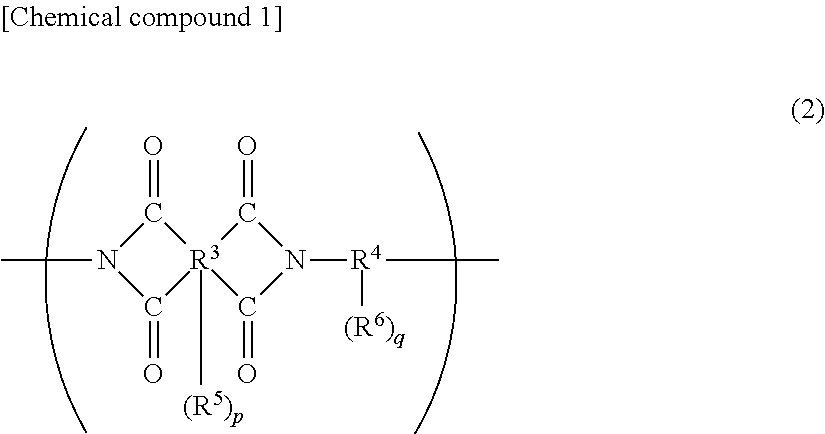Cured film and positive photosensitive resin composition
a technology of photosensitive resin and cure film, which is applied in the direction of photomechanical equipment, instruments, and semiconductor/solid-state device details, etc., can solve the problems of low resistance of organic luminescent materials to gas components, poor long-term reliability of organic el display devices, and shrinkage of pixels, so as to achieve long-term reliability and high long-term reliability
- Summary
- Abstract
- Description
- Claims
- Application Information
AI Technical Summary
Benefits of technology
Problems solved by technology
Method used
Image
Examples
synthesis example 1
Synthesis of Hydroxyl Group-Containing Diamine Compounds
[0156]First, 18.3 g (0.05 mole) of 2,2-bis(3-amino-4-hydroxyphenyl) hexafluoropropane (hereinafter referred to as BAHF) was dissolved in 100 mL of acetone and 17.4 g (0.3 mole) of propylene oxide, and cooled to −15° C. Then, a solution of 20.4 g (0.11 mole) of 3-nitrobenzoyl chloride dissolved in 100 mL of acetone was added dropwise. After the end of dropping, the solution was allowed to react at −15° C. for 4 hours, followed by allowing it to return to room temperature. The resulting white solid precipitate was separated out by filtration and vacuum-dried at 50° C.
[0157]A 30 g portion of the solid material was placed in a 300 mL stainless steel autoclave and dispersed in 250 mL of methyl cellosolve, followed by adding 2 g of 5% palladium-carbon. Then, a balloon was used to introduce hydrogen to cause a reduction reaction at room temperature. After about 2 hours, the reaction was finished after checking that the balloon would b...
synthesis example 2
Synthesis of Alkali-Soluble Resin (A-1)
[0158]In a dry nitrogen flow, 31.0 g (0.10 mole) of 3, 3′, 4, 4′-diphenyl ether tetracarboxylic dianhydride (hereinafter referred to as ODPA) was dissolved in 500 g of N-methyl-2-pyrrolidone (NMP). Here, 45.35 g (0.075 mole) of the hydroxyl group-containing diamine compound prepared in Synthesis example 1 and 1.24 g (0.005 mole) of 1,3-bis(3-aminopropyl) tetramethyl disiloxane were added together with 50 g of NMP, followed by performing reaction at 20° C. for 1 hour and additional reaction at 50° C. for 2 hours. Then, 4.36 g (0.04 mole) of 4-aminophenol, used as end-capping agent, was added together with 5 g of NMP, followed by performing reaction at 50° C. for 2 hours. Subsequently, a solution prepared by diluting 28.6 g (0.24 mole) of N,N-dimethylformamide dimethylacetal with 50 g of NMP was added dropwise over 10 minutes. After the dropping, stirring was performed at 50° C. for 3 hours. After the stirring, the solution was cooled to room tem...
synthesis example 3
Synthesis of Alkali-Soluble Resin (A-2)
[0159]In a dried nitrogen flow, 29.3 g (0.08 mole) of BAHF, 1.24 g (0.005 mole) of 1,3-bis(3-aminopropyl) tetramethyl disiloxane, and 3.27 g (0.03 mole) of 3-aminophenol, which was used as end capping agent, were dissolved in 150 g N-methyl-2-pyrrolidone (NMP). To this solution, 31.0 g (0.1 mole) of ODPA was added together with 50 g of NMP, stirred at 20° C. for 1 hour, and additionally stirred at 50° C. for 4 hours. Subsequently, 15 g of xylene was added and stirred at 150° C. for 5 hours while distilling water together with xylene. After the stirring, the solution was poured in 3 L of water and the resulting white precipitate was collected. This precipitate was collected by filtration, rinsed with water three times, and dried in a vacuum drying machine at 80° C. for 24 hours to provide a polyimide, that is, the alkali-soluble resin (A-2).
PUM
| Property | Measurement | Unit |
|---|---|---|
| boiling point | aaaaa | aaaaa |
| boiling point | aaaaa | aaaaa |
| temperature | aaaaa | aaaaa |
Abstract
Description
Claims
Application Information
 Login to View More
Login to View More - R&D
- Intellectual Property
- Life Sciences
- Materials
- Tech Scout
- Unparalleled Data Quality
- Higher Quality Content
- 60% Fewer Hallucinations
Browse by: Latest US Patents, China's latest patents, Technical Efficacy Thesaurus, Application Domain, Technology Topic, Popular Technical Reports.
© 2025 PatSnap. All rights reserved.Legal|Privacy policy|Modern Slavery Act Transparency Statement|Sitemap|About US| Contact US: help@patsnap.com



